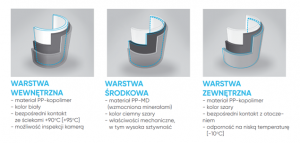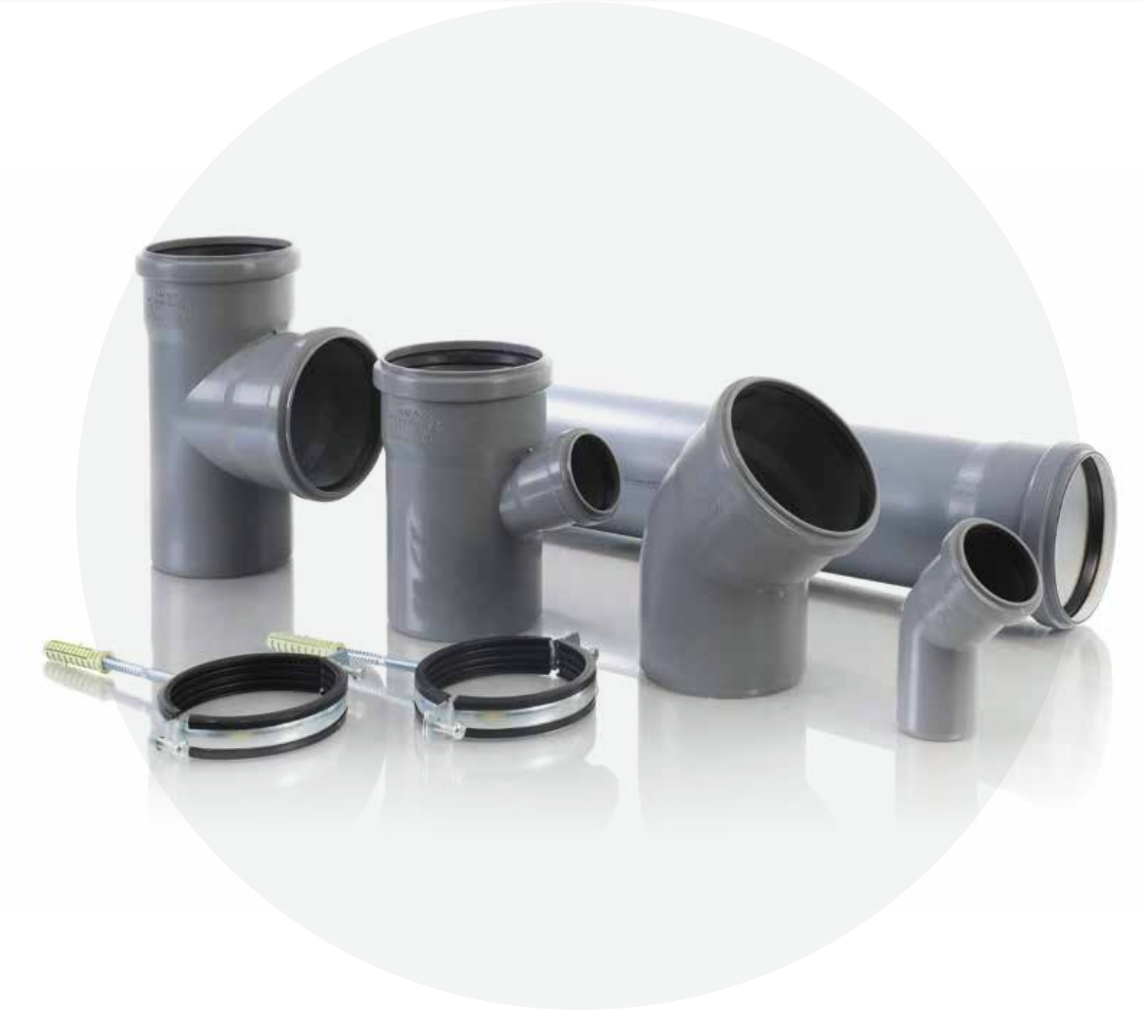Chyba każdy z nas słyszał specyficzne szumy biegnące z rur kanalizacyjnych. Spływające ścieki bytowo-gospodarcze mogą być drażniące dla ucha powodując przy tym dyskomfort. Spokój i bezpieczeństwo to dla użytkowników budynku ważne aspekty stanowiące komfort życia. Gwarancją może być kanalizacja tzw. niskoszumowa.
Skąd się biorą odgłosy z rur w kanalizacji?
W obecnych czasach powszechnie stosowane rury kanalizacyjne produkowane są z tworzyw sztucznych, które są lekkie. Woda i ścieki zwykle opadają w sposób gwałtowny, odbijając się od ścianek rur. Strumień wpada wówczas w wibrację i wraz z powietrzem przenosi falę akustyczną do otoczenia. Niepożądane dźwięki powstają w wyniku niedostatecznej stabilizacji lekkiej rury. Zwykłe, powszechnie stosowane rury do kanalizacji wewnętrznej słabiej tłumią dźwięki przelewających ścieków. Takie sytuacje bywają uciążliwe, szczególnie w budynkach, w których ściany są cienkie i przepuszczają fale akustyczne. Kanalizacja niskoszumowa może w znacznym stopniu pochłonąć nieprzyjemne odgłosy.
Gdzie warto zastosować kanalizację niskoszumową?
Aby uniknąć niepożądanych hałasów kanalizacja wewnętrzna powinna być starannie wygłuszona. Rury niskoszumowe zostały stworzone z materiałów dźwiękochłonnych, które pochłaniają fale dźwiękowe. Z tego właśnie powodu montuje się je w budynkach, gdzie ochrona przed hałasem jest bardzo ważna, np. w budynkach wielorodzinnych, hotelach, laboratoriach, biurach czy szpitalach.
Elementy kanalizacji niskoszumowej można zastosować do budowy kompletnego układu kanalizacji, rozpoczynając od podejść do przyborów sanitarnych, przez piony kanalizacyjne do połączenia z kanalizacją zewnętrzną. Większość hałasów słyszanych z kanalizacji powstaje w pionie kanalizacyjnym.
Jaką rolę spełnia kanalizacja niskoszumowa?
Rury kanalizacji niskoszumowej przeznaczone są do budowy wewnętrznych instalacji kanalizacji grawitacyjnej. System kanalizacji niskoszumowej ma za zadanie odprowadzać nieczystości i ścieki pochodzenia bytowo-gospodarczego w sposób bezpieczny, cichy i bezwonny. Kanalizacja niskoszumowa sprosta powyższym zadaniom tyko wtedy, gdy elementy systemu niskoszumowego spełnią wszelkie niezbędne wymogi ochrony akustycznej w pomieszczeniach. Rury o różnych średnicach i długościach oraz kształtki wykonane są z wysokiej jakości polipropylenu. Producenci dodatkowo wzmacniają i uszlachetniają rury, aby system posiadał odpowiednie właściwości mechaniczne i był odporny na skrajne temperatury. Istotne jest także użycie specjalnych obejm mocujących system do ścian. W odróżnieniu od zwykłych uchwytów, obejmy w kanalizacji niskoszumowej powinny zawierać gumę tłumiącą drgania powodowane przez spadający strumień nieczystości w rurach.
Dlaczego warto wybrać system kanalizacji wewnętrznej AmaxPro
System kanalizacji wewnętrznej AmaxPro jest atrakcyjną cenowo propozycją dla wszelkich inwestycji, jednocześnie spełniając przy tym wymagania norm akustycznych i budowlanych. Rury produkowane są metodą wytłaczania, a kształtki wytwarzane są metodą wtryskową. Poszczególne warstwy rur niskoszumowych AmaxPro wytłaczane są wspólnie, dając w efekcie trójwarstwową rurę strukturalną. Redukcję hałasów oraz wyjątkową wytrzymałość kanalizacji uzyskuje się dzięki zastosowaniu odpowiednich minerałów dodanych podczas produkcji rur. Każda warstwa rury posiada wyjątkową cechę mechaniczną oraz użytkową.

W porównaniu ze zwykłą kanalizacją wewnętrzną system AmaxPro jest wyjątkowo odporny na uszkodzenia mechaniczne w transporcie i podczas montażu oraz długie magazynowanie. Pod wpływem działania czynników atmosferycznych poszczególne elementy nie zmieniają swojej struktury.
AmaxPro gwarantuje również szczelność połączeń w czasie eksploatacji nawet w temperaturach poniżej -10°C. W zwykłej kanalizacji w takich warunkach można spodziewać się pęknięć, które powodują wydostawanie się z kanalizacji przykrych zapachów. Kolejną zaletą systemu niskoszumowego Amaxpro jest bezpieczne transportowanie gorących ścieków +90°C, co nie wpływa na strukturę rur. Coraz częściej w budownictwie praktykuje się inspekcję kanalizacji wykorzystując przy tym kamerki. Dzięki białej warstwie rury wewnątrz szybka rewizja i lokalizacja zatoru w systemie AmaxPro nie będzie problemem. Jeśli chcesz zapobiec błędom w instalacji kanalizacyjnej przeczytaj tutaj.
Zalety zastosowania systemu kanalizacji wewnętrznej AmaxPro
- NISKOSZUMOWOŚĆ
Trójwarstwowa konstrukcja rurociągu
Podwyższona sztywność obwodowa
Wzmocnienie związkami mineralnymi - ODPORNOŚĆ
Trwały montaż i użytkowanie poniżej -10° C
Bezpieczny transport gorących ścieków
+90° C – stała, +95° C – chwilowa
Magazynowanie w warunkach zimowych - TRANSPARENTNOŚĆ
Biała warstwa wewnętrzna rurociągu
Łatwa kontrola jakości wykonanych prac
Szybka lokalizacja zatorów
Kanalizacja niskoszumowa zdecydowanie może poprawić komfort życia. W porównaniu do standardowych elementów odprowadzających ścieki bytowo-gospodarcze wzmocniony system niskoszumowy doskonale pochłania fale dźwiękowe. Oprócz tego jest wyjątkowo odporny na działanie czynników mechanicznych, środowiskowych. Wymagający użytkownicy ceniący sobie spokój i bezpieczeństwo bez nieprzyjemnych odgłosów czy zapachów, nie powinni wahać się z wyborem odpowiedniego systemu kanalizacji.
